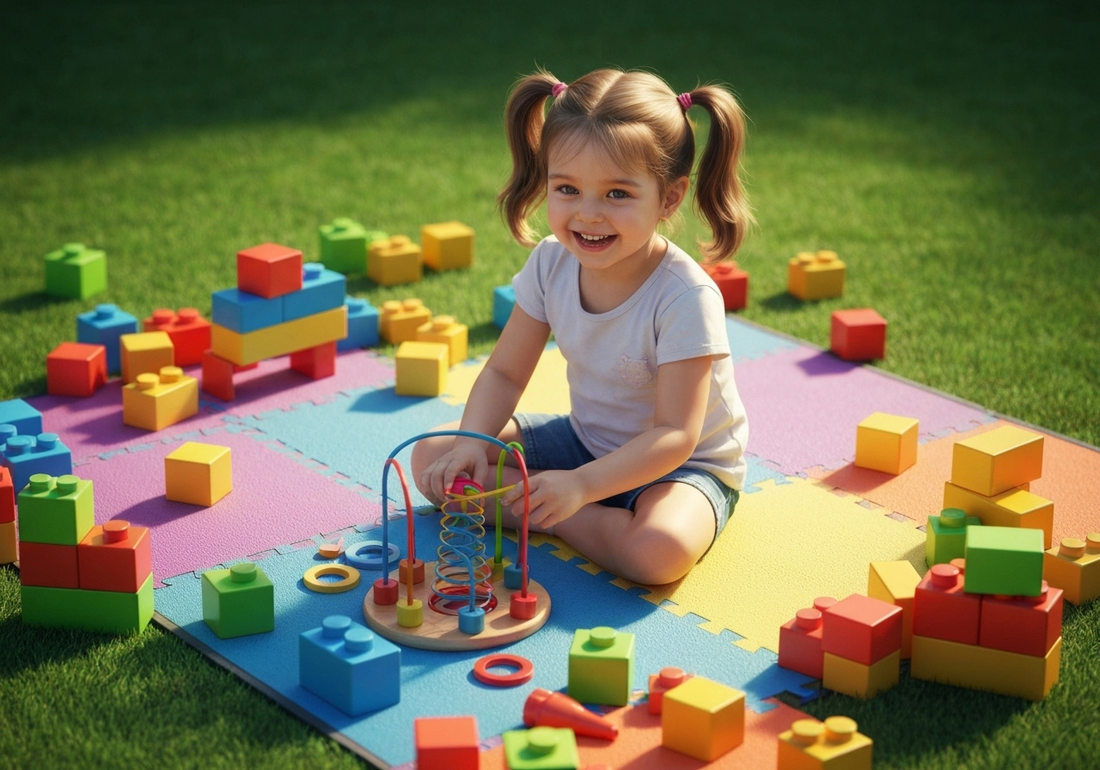Key Highlights
- Wooden lacing games are excellent motor skills toys that help develop crucial fine motor skills in children.
- These toys engage young minds with an interactive and fun way to learn hand-eye coordination.
- Threading colorful laces through various shapes boosts creativity and problem-solving abilities.
- High-quality lacing toys feature sturdy construction and smooth edges, meeting safety industry standards.
- They are suitable for a broad age range, supporting developmental milestones from toddlerhood through early elementary years.
- Choosing toys made with certified, non-toxic materials ensures a safe play experience.
Introduction
Are you looking for a toy that is both fun and developmental for your child? Wooden lacing games offer a fantastic way to give your little one a head start. These classic toys are meticulously designed to be more than just a pastime; they are powerful tools for growth. By engaging with these simple yet effective games, children can significantly enhance their fine motor skills, hand-eye coordination, and problem-solving abilities. Measuring 16.5 x 15.5 cm, this playful activity strengthens hand muscles and sharpens cognitive skills, preparing them for future learning challenges.
Why Lacing Games Wooden Toys Are a Must-Have for Kids

Lacing games are a valuable addition to any child’s playroom, serving as a cornerstone for early childhood development. They are designed to captivate young minds by combining tactile engagement with visual appeal, making them perfect for a broad age range.
The simple act of threading colorful laces through wooden blocks helps build foundational cognitive skills and patience. This focused activity supports your child's ability to concentrate while providing a sense of accomplishment, making learning feel like play. If you're interested in buying unique or handmade wooden lacing games online, consider checking out specialty toy shops on platforms like Etsy or independent retailers dedicated to high-quality, handcrafted wooden toys.
Key Benefits for Early Childhood Development
Wooden lacing games offer a wealth of benefits that contribute directly to your child's developmental journey. These toys are specifically designed to target and strengthen the small muscles in a child’s hands and fingers. This improvement in dexterity is essential for tasks like writing, buttoning, and other daily activities.
Beyond physical development, these toys are instrumental in boosting cognitive skills. As children work to thread laces through holes, they enhance their concentration and problem-solving abilities. According to one toy expert, HABA USA, lacing toys help "refine their motor skills while also exercising creativity and problem-solving abilities, providing benefits for both parents and caregivers. This dual benefit makes them a powerful educational tool.
The key advantages include:
- Enhanced Hand-Eye Coordination: Children learn to guide the lace with precision, improving the connection between what they see and what their hands do.
- Improved Concentration: The task requires focus, helping children lengthen their attention spans over time.
- Problem-Solving Skills: Navigating the lace through different holes and patterns encourages logical thinking.
How Lacing Toys Spark Creativity and Imagination
One of the most wonderful aspects of wooden lacing toys is their ability to unlock a child's creativity and imagination. Unlike toys with a single function, lacing games are open-ended, providing a canvas for self-expression. The simple components—a wooden shape and a lace—can be used in countless ways.
This provides an interactive way for children to engage in imaginative play. They might pretend the lace is a worm wiggling through an apple or a snake slithering through the grass. These narratives transform a simple motor skills activity into a story, fostering both creativity and language development.
In an educational setting, educators can use these toys to teach colors, patterns, and sequences. You can encourage your child to create specific patterns with the lace or use different colored beads to introduce basic math concepts. This blend of structured learning and free play makes lacing toys a versatile tool for nurturing imagination.
Building Fine Motor Skills with Wooden Lacing Games
Wooden lacing games are exceptionally effective at building fine motor skills. The primary action of grasping a lace and guiding it through various holes requires precise control over the small muscles in the hands and fingers. This repetitive motion strengthens grip and improves finger dexterity.
This targeted practice is crucial for developing the hand-eye coordination necessary for writing, drawing, and using utensils. As your child masters the lacing process, they are simultaneously refining the motor skills that will support their academic and personal independence for years to come.
Lacing Activities for Improving Hand-Eye Coordination
Improving hand-eye coordination is a key benefit of playing with lacing toys. This skill involves the brain processing visual information to guide hand movements accurately, and brain damage can significantly impact this process. When a child threads a lace, they must watch the tip of the lace and the target hole simultaneously, making constant adjustments.
Threading activities with various shapes and patterns challenge a child's developing abilities in a fun, low-pressure environment. The act of manipulating the lace and the wooden piece encourages bilateral coordination, as both hands must work together to complete the task. This strengthens the connection between the brain's hemispheres, which is vital for complex motor skills.
Here are a few activities that specifically target this skill:
- Pattern Following: Use lacing cards with printed patterns for your child to replicate.
- Bead Stringing: Stringing wooden beads of different sizes onto a lace improves precision.
- Shape Lacing: Lacing around the perimeter of different wooden shapes helps children learn to control their movements around corners and curves.
Age-Appropriate Milestones for Motor Skill Growth
Wooden lacing games are beneficial across a wide age range, typically from 18 months through the early elementary years. As children grow, their ability to manipulate objects and perform complex tasks evolves. Lacing toys can be adapted to match these developmental milestones, providing the right level of challenge at each stage.
For toddlers, the focus is on basic threading with large beads and simple shapes. This helps develop the foundational grip and control of the small muscles in their hands. As they enter preschool, they can tackle more intricate patterns and smaller holes, refining their precision and patience.
By the time they reach their early elementary years, children can use lacing toys for creative expression, inventing their own complex designs. Below is a table outlining typical milestones.
|
Age Group |
Motor Skill Milestones with Lacing Toys |
|---|---|
|
18-24 Months |
Can grasp and thread large, chunky beads onto a thick lace with some assistance. |
|
2-3 Years |
Begins to thread with more independence and can follow a simple, in-and-out lacing pattern. |
|
3-5 Years |
Develops the dexterity to lace more complex shapes and can start replicating simple patterns. |
|
5+ Years |
Masters intricate lacing techniques and uses the toy for creative and imaginative play. |
Choosing Safe and Durable Wooden Lacing Toys in India
When selecting a wooden lacing toy for your child, safety should always be the utmost care and top priority. Look for products made with sturdy construction that can withstand enthusiastic play. The best toys have smooth edges and are finished with non-toxic paints to ensure a completely safe play experience for your little one.
To guarantee quality, choose toys from reputable brands that use certified materials and adhere to rigorous safety testing protocols. This attention to detail provides peace of mind, allowing your child to explore and learn without risk. Many Indian artisans create beautiful, safe toys, such as Channapatna toys, which are known for their natural dyes and finishes.
Safety Guidelines and Certified Materials
Ensuring your child's toy is safe involves more than just a quick visual check. Opting for toys made from certified materials is the best way to guarantee they are free from harmful chemicals like BPA, phthalates, and lead, which can be present in low-quality plastic toys. Wooden toys are often seen as a safer alternative due to their natural composition and durability.
High-quality wooden toys undergo rigorous safety testing to meet or exceed international standards. This process checks for potential hazards, such as sharp points or small parts that could break off. The hallmark of a well-made wooden toy is its perfectly sanded smooth edges, which prevent splinters and are gentle on little hands.
For complete peace of mind, follow these guidelines:
- Check for Certifications: Look for labels indicating the toy meets safety standards like ASTM in the US or EN71 in Europe.
- Inspect the Finish: Ensure paints and finishes are explicitly labeled as non-toxic and child-safe.
- Assess for Choking Hazards: For children under three, make sure all parts of the toy are large enough not to be a choking risk.
Tips for Selecting the Best Lacing Game for Your Child
Finding the perfect lacing game involves balancing fun, safety, and developmental appropriateness. The durability of the toy is a key factor; a product with sturdy construction will last for years, offering excellent value and reducing waste. Always choose toys that meet or exceed industry standards for safety and quality.
Consider your child's current age and interests. A toddler will benefit from a simple set with large, easy-to-grasp pieces, while a preschooler may be ready for a set with more complex shapes and patterns. Selecting a theme that fascinates your child, such as animals, vehicles, or fruits, will make the educational experience even more engaging.
Here are a few final tips for your selection:
- Age Appropriateness: Match the complexity of the toy to your child’s developmental stage.
- Material Quality: Opt for solid wood, which is less likely to splinter or break than composite materials.
- Educational Value: Choose sets that can be used to teach colors, numbers, or sequencing to maximize learning opportunities.
Conclusion
In conclusion, lacing games made of wood are not just toys; they offer a plethora of benefits as vital tools for fostering a child's development. By engaging in these activities, children enhance their fine motor skills, boost creativity, and improve hand-eye coordination—essential milestones that contribute to their overall growth. Moreover, choosing safe and durable wooden toys ensures a worry-free play experience for both parents and kids. As you explore the world of lacing games, remember that investing in quality toys reaps long-lasting benefits for your child's learning journey. To make this experience even better, don't hesitate to reach out for a consultation on selecting the best lacing toys tailored to your child's needs.
Frequently Asked Questions
What educational aspects do wooden lacing games offer?
Wooden lacing games support early childhood development by improving fine motor skills and cognitive skills. They offer an interactive way to enhance hand-eye coordination, concentration, and problem-solving abilities, making them a powerful tool for building foundational motor skills.
How do wooden lacing toys compare to plastic lacing toys in safety and quality?
Wooden toys often surpass plastic ones in quality and safety due to their durability and sturdy construction. Made from certified materials with smooth edges, they are less likely to contain harmful chemicals. High-quality wooden toys meet rigorous safety standards, offering greater peace of mind.
Are there creative ways to use lacing games in early childhood education?
Absolutely. Lacing games can be used to teach colors, counting, and sequencing. Encourage children to create stories with the various shapes or design their own patterns with colorful laces. This fosters creativity, imagination, and narrative skills in a hands-on way.


